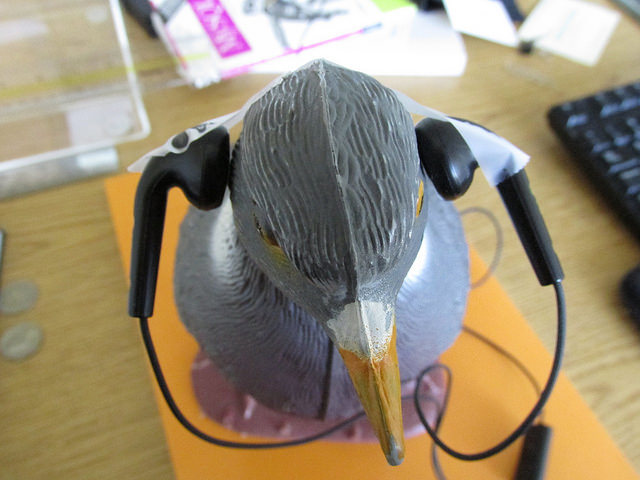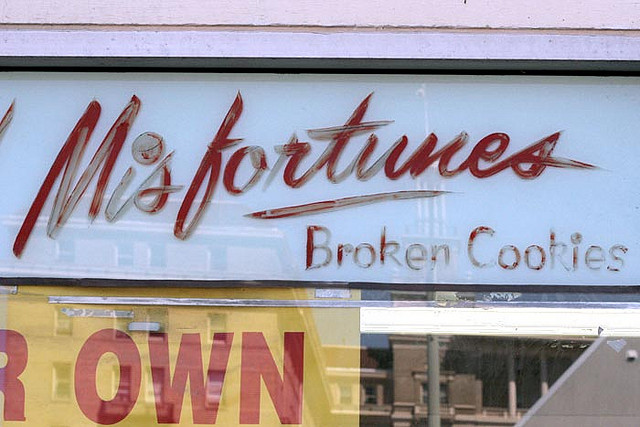Archive for the ‘The Future’ Category
Diversity Through Podcasts
 Podcasts are short bursts of learning curated to please your ear. And with training budgets slashed, podcasts can be a wonderful and cost effective (free) way to learn.
Podcasts are short bursts of learning curated to please your ear. And with training budgets slashed, podcasts can be a wonderful and cost effective (free) way to learn.
The only way to battle uncertainty is to increase diversity. Bringing together people with diverse experiences lets us see things from multiple perspectives so we can better navigate uncertain terrain. But increasing your personal diversity helps too. Giving yourself new knowledge from diverse fields helps you broaden your perspective and makes you better at handling the uncertainty that comes with life.
The hard part about podcasts is deciding which ones to listen to. In my work to increase my diversity, I’ve listened to a lot of podcasts. Some were interesting and inspiring and others weren’t.
Below are some of my favorite podcast episodes. There’s a short description of each one, along with what I learned from them. Click the link to take you to the episode and you can listen to each one. No need to download. Just find the play button and click it.
Enjoy.
9-Volt Nirvana (Radiolab) — I learned about how the brain works and how it can be supercharged (with a 9-volt battery) to learn faster. I listened to this one on a long car ride with my daughter. She doesn’t like podcasts, but she was captivated by this one.
The Living Room (Love and Radio) — A story about how things can look differently than they are, especially when looking from the outside. I learned how our assumptions and the stories we tell ourselves shape how we see the world. This one is emotionally gripping.
Guided by Voices (Benjamin Walker’s Theory of Everything) — How Kant and Kepler both tried (and failed) to record the universal harmonies Pythagoras once heard. They struggled to make peace with the irrationality and disharmony of nature. I learned disharmony is natural and to embrace it. There’s a segment in the middle that’s not about Kant and Kepler that you may want to skip. To skip that segment, listen from the beginning and at 9:30 skip to 23:07 and listen to the end.
Eckhart Tolle’s The Power of Now (On Being) — I love Eckhart’s voice and his chuckle. I learned how I am not my emotions; I am the space for my emotions. And I learned about the Pain Body. That, on its own, was worth it. Krista Tippett is a brilliant interviewer.
Belt Buckle (Mystery Show) — A story about a long-lost belt buckle and its journey home. I learned how we attach meaning to objects, and that can be a good thing.
The Wrath of the Khans 1 (Dan Carlin’s Hardcore History) — This is a riveting story of Genghis Khan. Dan Carlin is wonderful – he sits you right in the middle of history. (Listen for two minutes and you’ll feel it.) I learned the power of personal will and how history changes over time. To skip Dan’s wonderful introduction and get a feel for the Great Khan, start at 19:00 and listen for 10 minutes. If you like what you hear, keep listening. This podcast is long almost 2 hours and it’s the first of a series of five on the Great Khan. This is one of my most favorite favorites.
image credit — mpclemens
Strategic Planning is Dead.
 Things are no longer predictable, and it’s time to start behaving that way.
Things are no longer predictable, and it’s time to start behaving that way.
In the olden days (the early 2000s) the pace of change was slow enough that for most the next big thing was the same old thing, just twisted and massaged to look like the next big thing. But that’s not the case today. Today’s pace is exponential, and it’s time to behave that way. The next big thing has yet to be imagined, but with unimaginable computing power, smart phones, sensors on everything and a couple billion new innovators joining the web, it should be available on Alibaba and Amazon a week from next Thursday. And in three weeks, you’ll be able to buy a 3D printer for $199 and go into business making the next big thing out of your garage. Or, you can grasp tightly onto your success and ride it into the ground.
To move things forward, the first thing to do is to blow up the strategic planning process and sweep the pieces into the trash bin of a bygone era. And, the next thing to do is make sure the scythe of continuous improvement is busy cutting waste out of the manufacturing process so it cannot be misapplied to the process of re-imagining the strategic planning process. (Contrary to believe, fundamental problems of ineffectiveness cannot be solved with waste reduction.)
First, the process must be renamed. I’m not sure what to call it, but I am sure it should not have “planning” in the name – the rate of change is too steep for planning. “Strategic adapting” is a better name, but the actual behavior is more akin to probe, sense, respond. The logical question then – what to probe?
[First, for the risk minimization community, probing is not looking back at the problems of the past and mitigating risks that no longer apply.]
Probing is forward looking, and it’s most valuable to probe (purposefully investigate) fertile territory. And the most fertile ground is defined by your success. Here’s why. Though the future cannot be predicted, what can be predicted is your most profitable business will attract the most attention from the billion, or so, new innovators looking to disrupt things. They will probe your business model and take it apart piece-by-piece, so that’s exactly what you must do. You must probe-sense-respond until you obsolete your best work. If that’s uncomfortable, it should be. What should be more uncomfortable is the certainty that your cash cow will be dismantled. If someone will do it, it might as well be you that does it on your own terms.
Over the next year the most important work you can do is to create the new technology that will cause your most profitable business to collapse under its own weight. It doesn’t matter what you call it – strategic planning, strategic adapting, securing the future profitability of the company – what matters is you do it.
Today’s biggest risk is our blindness to the immense risk of keeping things as they are. Everything changes, everything’s impermanent – especially the things that create huge profits. Your most profitable businesses are magnates to the iron filings of disruption. And it’s best to behave that way.
Image credit – woodleywonderworks
Compete with No One
 Today’s commercial environment is fierce. All companies have aggressive growth objectives that must be achieved at all costs. But there’s a problem – within any industry, when the growth goals are summed across competitors, there are simply too few customers to support everyone’s growth goals. Said another way, there are too many competitors trying to eat the same pie. In most industries it’s fierce hand-to-hand combat for single-point market share gains, and it’s a zero sum game – my gain comes at your loss. Companies surge against each other and bloody skirmishes break out over small slivers of the same pie.
Today’s commercial environment is fierce. All companies have aggressive growth objectives that must be achieved at all costs. But there’s a problem – within any industry, when the growth goals are summed across competitors, there are simply too few customers to support everyone’s growth goals. Said another way, there are too many competitors trying to eat the same pie. In most industries it’s fierce hand-to-hand combat for single-point market share gains, and it’s a zero sum game – my gain comes at your loss. Companies surge against each other and bloody skirmishes break out over small slivers of the same pie.
The apex of this glorious battle is reached when companies no longer have points of differentiation and resort to competing on price. This is akin to attrition warfare where heavy casualties are taken on both sides until the loser closes its doors and the winner emerges victorious and emaciated. This race to the bottom can only end one way – badly for everyone.
Trench warfare is no way for a company to succeed, and it’s time for a better way. Instead of competing head-to-head, it’s time to compete with no one.
To start, define the operating envelope (range of inputs and outputs) for all the products in the market of interest. Once defined, this operating envelope is off limits and the new product must operate outside the established design space. By definition, because the new product will operate with input conditions that no one else’s can and generate outputs no one else can, the product will compete with no one.
In a no-to-yes way, where everyone’s product says no, yours is reinvented to say yes. You sell to customers no one else can; you sell into applications no one else can; you sell functions no one else can. And in a wicked googly way, you say no to functions that no one else would dare. You define the boundary and operate outside it like no one else can.
Competing against no one is a great place to be – it’s as good as trench warfare is bad – but no one goes there. It’s straightforward to define the operating windows of products, and, once define it’s straightforward to get the engineers to design outside the window. The hard part is the market/customer part. For products that operate outside the conventional window, the sales figures are the lowest they can be (zero) and there are just as many customers (none). This generates extreme stress within the organization. The knee-jerk reaction is to assign the wrong root cause to the non-existent sales. The mistake – “No one sells products like that today, so there’s no market there.” The truth – “No one sells products like that today because no one on the planet makes a product like that today.”
Once that Gordian knot is unwound, it’s time for the marketing community to put their careers on the line. It’s time to push the organization toward the scary abyss of what could be very large new market, a market where the only competition would be no one. And this is the real hard part – balancing the risk of a non-existent market with the reward of a whole new market which you’d call your own.
If slugging it out with tenacious competitors is getting old, maybe it’s time to compete with no one. It’s a different battle with different rules. With the old slug-it-out war of attrition, there’s certainty in how things will go – it’s certain the herd will be thinned and it’s certain there’ll be heavy casualties on all fronts. With new compete-with-no-one there’s uncertainty at every turn, and excitement. It’s a conflict governed by flexibility, adaptability, maneuverability and rapid learning. Small teams work in a loosely coordinated way to test and probe through customer-technology learning loops using rough prototypes and good judgement.
It’s not practical to stop altogether with the traditional market share campaign – it pays the bills – but it is practical to make small bets on smart people who believe new markets are out there. If you’re lucky enough to have folks willing to put their careers on the line, competing with no one is a great way to create new markets and secure growth for future generations.
Image credit – mae noelle
Purposeful Violation of the Prime Directive
 In Star Trek, the Prime Directive is the over-arching principle for The United Federation of Planets. The intent of the Prime Directive is to let a sentient species live in accordance with its normal cultural evolution. And the rules are pretty simple – do whatever you want as long as you don’t violate the Prime Directive. Even if Star Fleet personnel know the end is near for the sentient species, they can do nothing to save it from ruin.
In Star Trek, the Prime Directive is the over-arching principle for The United Federation of Planets. The intent of the Prime Directive is to let a sentient species live in accordance with its normal cultural evolution. And the rules are pretty simple – do whatever you want as long as you don’t violate the Prime Directive. Even if Star Fleet personnel know the end is near for the sentient species, they can do nothing to save it from ruin.
But what does it mean to “live in accordance with the normal cultural evolution?” To me it means “preserve the status quo.” In other words, the Prime Directive says – don’t do anything to challenge or change the status quo.
Though today’s business environment isn’t Star Trek and none of us work for Star Fleet, there is a Prime Directive of sorts. Today’s Prime Directive deals not with sentient species and their cultures but with companies and their business models, and its intent is to let a company live in accordance with the normal evolution of its business model. And the rules are pretty simple – do whatever you want as long as you don’t violate the Prime Directive. Even if company leaders know the end is near for the business model, they can do nothing to save it from ruin.
Business models, and their decrepit value propositions propping them up, don’t evolve. They stay just as they are. From inside the company the business model and value proposition are the very things that provide sustenance (profitability). They are known and they are safe – far safer than something new – and employees defend them as diligently as Captain Kirk defends his Prime Directive. With regard to business models, “to live in accordance with its natural evolution” is to preserve the status quo until it goes belly up. Today’s Prime Directive is the same as Star Trek’s – don’t do anything to challenge or change the status quo.
Innovation brings to life things that are novel, useful, and successful. And because novel is the same as different, innovation demands complete violation of today’s Prime Directive. For innovators to be successful, they must blow up the very things the company holds dear – the declining business model and its long-in-the-tooth value proposition.
The best way to help innovators do their work is to provide them phasers so they can shoot those in the way of progress, but even the most progressive HR departments don’t yet sanction phasers, even when set to “stun”. The next best way is to educate the company on why innovation is important. Company leaders must clearly articulate that business models have a finite life expectancy (measured in years, not decades) and that it’s the company’s obligation to disrupt and displace it.them.
The Prime Directive has a valuable place in business because it preserves what works, but it needs to be amended for innovation. And until an amendment is signed into law, company leaders must sanction purposeful violation of the Prime Directive and look the other way when they hear the shrill ring a phaser emanating from the labs.
Image credit – svenwerk
Innovation Fortune Cookies
 If they made innovation fortune cookies, here’s what would be inside:
If they made innovation fortune cookies, here’s what would be inside:
If you know how it will turn out, you waited too long.
Whether you like it or not, when you start something new uncertainty carries the day.
Don’t define the idealized future state, advance the current state along its lines of evolutionary potential.
Try new things then do more of what worked and less of what didn’t.
Without starting, you never start. Starting is the most important part
Perfection is the enemy of progress, so are experts.
Disruption is the domain of the ignorant and the scared.
Innovation is 90% people and the other half technology.
The best training solves a tough problem with new tools and processes, and the training comes along for the ride.
The only thing slower than going too slowly is going too quickly.
An innovation best practice – have no best practices.
Decisions are always made with judgment, even the good ones.
image credit – Gwen Harlow
Don’t boost innovation, burst it.
 The most difficult part of innovation is starting, and the best way to start is the Innovation Burst Event, or IBE. The IBE is a short, focused event with three objectives: to learn innovation methods, to provide hands-on experience, and to generate actual results. In short, the IBE is a great way to get started.
The most difficult part of innovation is starting, and the best way to start is the Innovation Burst Event, or IBE. The IBE is a short, focused event with three objectives: to learn innovation methods, to provide hands-on experience, and to generate actual results. In short, the IBE is a great way to get started.
There are a couple flavors of IBEs, but the most common is a single day even where a small, diverse group gets together to investigate some bounded design space and to create novel concepts. At the start, a respected company leader explains to the working group the importance of the day’s work, how it fits with company objectives, and sets expectations there will be a report out at the end of the day to review the results. During the event, the working group is given several design challenges, and using innovation tools/methods, creates new concepts and builds “thinking prototypes.” The IBE ends with a report out to company leaders, where the working group identifies patentable concepts and concepts worthy of follow-on work. Company leaders listen to the group’s recommendations and shape the go-forward actions.
The key to success is preparation. To prepare, interesting design space is identified using multiple inputs: company growth objectives, new market development, the state of the technology, competitive landscape and important projects that could benefit from new technology. And once the design space is identified, the right working group is selected. It’s best to keep the group small yet diverse, with several important business functions represented. In order to change the thinking, the IBE is held at location different than where the day-to-day work is done – at an off-site location. And good food is provided to help the working group feel the IBE is a bit special.
The most difficult and most important part of preparation is choosing the right design space. Since the selection process starts with your business objectives, the design space will be in line with company priorities, but it requires dialing in. The first step is to define the operational mechanism for the growth objective. Do you want a new product or process? A new market or business model? The next step is to choose if you want to radically improve what you have (discontinuous improvement) or obsolete your best work (disruption). Next, the current state is defined (knowing the starting point is more important than the destination) – Is the technology mature? What is the completion up to? What is the economy like in the region of interest? Then, with all that information, several important lines of evolution are chosen. From there, design challenges are created to exercise the design space. Now it’s time for the IBE.
The foundation of the IBE is the build-to-think approach and its building blocks are the design challenges. The working group is given a short presentation on an innovation tool, and then they immediately use the tool on a design challenge. The group is given a short description of the design challenge (which is specifically constructed to force the group from familiar thinking), and the group is given an unreasonably short time, maybe 15-20 minutes, to create solutions and build thinking prototypes. (The severe time limit is one of the methods to generate bursts of creativity.) The thinking prototype can be a story board, or a crude representation constructed with materials on hand – e.g., masking tape, paper, cardboard. The group then describes the idea behind the prototype and the problem it solves. A mobile phone is used to capture the thinking and the video is used at the report out session. The process is repeated one or two times, based on time constraints and nature of the design challenges.
About an hour before the report out, the working group organizes and rationalizes the new concepts and ranks them against impact and effort. They then recommend one or two concepts worthy of follow on work and pull together high level thoughts on next steps. And, they choose one or two concept that may be patentable. The selected concepts, the group’s recommendations, and their high level plans are presented at the report out.
At the report out, company leaders listen to the working group’s thoughts and give feedback. Their response to the group’s work is crucial. With right speech, the report out is an effective mechanism for leaders to create a healthy innovation culture. When new behaviors and new thinking are praised, the culture of innovation moves toward the praise. In that way, the desired culture can be built IBE by IBE and new behaviors become everyday behaviors.
Innovation is a lot more than Innovation Burst Events, but they’re certainly a central element. After the report out, the IBE’s output (novel concepts) must be funneled into follow on projects which must be planned, staffed, and executed. And then, as the new concepts converge on commercialization, and the intellectual comes on line, the focus of the work migrates to the factory and the sales force.
The IBE is designed to break through the three most common innovation blockers – no time to do innovation; lack of knowledge of how do innovation (though that one’s often unsaid); and pie-in-the-sky, brainstorming innovation is a waste of time. To address the time issue, the IBE is short – just one day. To address the knowledge gap, the training is part of the event. And to address the pie-in-the-sky – at the end of the day there is tangible output, and that output is directly in line with the company’s growth objectives.
It’s emotionally challenging to do work that destroys your business model and obsoletes your best products, but that’s how it is with innovation. But for motivation, think about this – if your business model is going away, it’s best if you make it go away, rather than your competition. But your competition does end up changing the game and taking your business, I know how they’ll do it – with Innovation Burst Events.
Image credit – Pascal Bovet
Innovating from a Woman’s Perspective
Innovation is about selling different products and services to different customers. Different means growth because you’re not yet selling the different products and you’re not yet selling to the different customers.
If you can learn to see your customers differently, you’ll create new products that are different; and if you can learn to see your products and services differently, you’ll create new customers that are different.
Innovation is all about connecting the unconnected, and that’s what’s behind the push for diversity within innovation teams. A diverse group brings more things to connect and more perspectives to see connections.
And it’s best to innovate where there’s little to no competition. If you’re the only one developing new products for those new customers or your the only one creating a whole new community of customers, you’ll be more successful – your products have only to compete with products that don’t exist.
In almost every industry and market there’s a huge community of new customers just waiting for products and services that fit them – women. Women have ever more say over family finances, ever more buying power and, thankfully, ever more influence over our society. If you want to sell new and different products, you should learn how to innovate for women.
I’m not talking about the 1950’s-like worldview where men innovate and sell new dish detergent and vacuum cleaners to women. I’m talking about all products and all markets. What does a cordless drill look like when it’s designed for women? I don’t know because I’m a man. (The only thing I do know is it’s not the same old drill wrapped in pink. That’s just patronizing.
Plain and simple, women know best how to innovate for women.
The most important way to increase the diversity of your innovation teams is to add more women. Women can see unmet needs to which I, as a man, am blind. Women can connect things that I cannot. Women have an unique worldview that, as a man, I cannot fully appreciate.
If you really want a competitive advantage, replace some of your innovation leaders with women. And if you want to accelerate the transformation, your Chief Innovation Officer should be a woman.
There’s been a strong effort to teach STEAM/STEM to our girls and young women, and that’s good. But it’s time to create the climate where our girls and young women see themselves as the innovators of our future.
Image credit – Judepics.
Your money or your time, which is worth more?
 If you were given a choice – for the same number of hours worked you get 20% more money, or for 20% fewer hours worked you get the same money – which would you choose?
If you were given a choice – for the same number of hours worked you get 20% more money, or for 20% fewer hours worked you get the same money – which would you choose?
In real life it would not go that way, but set that aside for a moment. It’s a thought experiment, a choice between theoretical options as it assumes you’ll actually work the same hours for the extra money and assumes you’ll actually work less and get paid the same. If you actually had the choice, which would you choose?
To me it comes down to two questions: If you had more money, what would you actually do with it? And, if you had more free time, what would you actually do with it? But these questions aren’t theoretical. No kidding, with your current lifestyle, with your existing priorities, with how you live your life, what would you do with more money and what would you do with more time?
With more money, would you pay off some bills, buy some new stuff, save for college, go on vacation, donate to charity? With the money some well-worn options come quickly to mind. Would 20% more money make a substantial difference in your life, or would you slowly ratchet up your spending so the extra money is no longer extra, but essential?
With more time, what would you do? What are the top three that jump immediately into your brain? I think this one’s tougher. If instead of five days a week you worked four, what would that day off look like? If you had every Friday off (in addition to your existing vacation days), what would you do? Sure, for the first four Fridays you’d catch up on your sleep, but then what? The time-money seesaw is so lopsided, we don’t know even how to think about this.
I think the best use of your extra time would be to figure out what to do with your extra time. What if on your fifth Friday, with your sleep deficit behind you, you did nothing? I mean nothing in the true sense – you get up at your regular time, eat breakfast, shower up, and do nothing. I mean eight hours with no electronics, no laptop, no video games, no TV, no books, no phones, where it’s just you and your tedious thoughts? Actually, I think that would be too much time with yourself, and one hour a week would be enough to set you on your path.
Before you can decide what you’d do with your extra time, you have to figure out what you want from life and why you want it. And to do that, you need to allocate a regular time to sit and do nothing. And you don’t even have to think about what you want and why you want it. If you sit, it will find you.
Truth is you don’t need an extra day off every week to carve out an hour and sit quietly. But if you do sit quietly you will figure out what you want out of life and why you want it and then you will come up with some wonderful new ways to spend your time. And because those wonderful new things will be deeply grounded in what you want out of your life – you’ll create the time to actually do them.
We’re clear what our money will buy, but less clear on what our time is worth. You’re one hour away from tipping the balance and clearing things up.
How do you choose what to work on?
 There are always too many things to do, too much to work on. And because of this, we must choose. Some have more choice than others, but we all have choice. And to choose, there are several lenses we look through.
There are always too many things to do, too much to work on. And because of this, we must choose. Some have more choice than others, but we all have choice. And to choose, there are several lenses we look through.
What’s good enough? If it’s good enough, there’s no need to work on it. “Good enough” means it’s not a constraint; it’s not in the way of where you want to go.
What’s not good enough? If it’s not good enough, it’s important to work on it. “Not good enough” means it IS a constraint; it IS in the way; it’s blocking your destination.
What’s not happening? If it’s not happening and the vacancy is blocking you from your destination, work on it. Implicit in the three lenses is the assumption of an idealized future state, a well-defined endpoint.
It’s the known endpoint that’s used to judge if there’s a blocking constraint or something missing. And there are two schools of thought on idealized future states – the systems, environment, competition, and interactions are well understood and idealized future states are the way to go, or things are too complex to predict how things will go. If you’re a member of the idealized-future-state-is-the-way-to-go camp, you’re home free – just use your best judgment to choose the most important constraints and hit them hard. If you’re a believer in complexity and its power to scuttle your predictions, things are a bit more nuanced.
Where the future state folks look through the eyepiece of the telescope toward the chosen nebula, the complexity folks look through the other end of the telescope toward the atomic structure of where things are right now. Complexity thinkers think it’s best to understand where you are, how you got there, and the mindset that guided your journey. With that knowledge you can rough out the evolutionary potential of the future and use that to decide what to work on.
If you got here by holding on to what you had, it’s pretty clear you should try to do more of that, unless, of course, the rules have changed. And to figure out if the rules have changed? Well, you should run small experiments to test if the same rules apply in the same way. Then, do more of what worked and less of what didn’t. And if nothing works even on a small scale, you don’t have anything to hold onto and it’s time to try something altogether new.
If you got here with the hybrid approach – by holding on to what you had complimented with a healthy dose of doing new stuff (innovation), it’s clear you should try to do more of that, unless, of course, you’re trying to expand into new markets which have different needs, different customers, and different pocketbooks. To figure out what will work, runs small experiments, and do more of what worked and less of what didn’t. If nothing works, your next round of small experiments should be radically different. And again, more of what worked, less of what didn’t.
And if you’re a young company and have yet to arrive, you’re already running small experiments to see what will work, so keep going.
There’s a half-life to the things that got us here, and it’s difficult to predict their decay. That’s why it’s best to take small bets on a number of new fronts – small investment, broad investigation of markets, and fast learning. And there’s value in setting a rough course heading into the future, as long as we realize this type of celestial navigation must be informed by regular sextant sightings and course corrections they inform.
Image credit – Hubble Heritage.
Embrace Uncertainty
 There’s a lot of stress in the working world these days, and to me, it all comes down to our blatant disrespect of uncertainty.
There’s a lot of stress in the working world these days, and to me, it all comes down to our blatant disrespect of uncertainty.
In today’s reality, we ask for plans then demand strict adherence to the deliverables – on time, on budget, or else. We treat plans like they’re chiseled in granite, when really it should be more like dry erase markers and a whiteboard. Our markets are uncertain; customers’ behaviors are uncertain; competitors’ actions are uncertain; supply chains are uncertain, yet our plans are plans don’t reflect that reality. And when we expect absolute predictability and accountability, we create stress and anxiety and our people don’t want to try new things because that adds another level of uncertainty.
With a flexible, rubbery plan the first step informs the second, and this is the basis for the logical shift from robust plans to resilient ones. Plans should be less about forcing adherence and more about recognizing deviation. Today’s plans demand early recognition of something that did follow the plan and today’s teams must have the authority to respond quickly. However, after years of denying the powerful force of uncertainty and shooting the messenger, we’ve trained our people to hide the deviations. And, with our culture of control and accountability, our teams require our approval before any type of change, so their response time is, well, not timely.
At our core, we know uncertainty is a founding principle in our universe, and now it’s time to behave that way. It’s time to look inside and decide to embrace uncertainty. Accept it or not, acknowledge it or not, uncertainty is here to stay. Here are some words to guide your journey:
- Resilient not robust.
- Early detection, fast response.
- Many small plans, done in parallel.
- Do more of what works, and less of what doesn’t.
- Plans are meant to be re-planned.
And if you’re into innovation, this applies doubly.
Image credit – dfbphotos.
Inspiration, Imagination, and Innovation – in that order.
 Inspiration is the fuel for imagination and imagination is the power behind innovation.
Inspiration is the fuel for imagination and imagination is the power behind innovation.
All companies want innovation and try lots of stuff to increase its supply. But innovation isn’t a thing in itself and not something to be conjured from air – it’ a result of something. The backplane of innovation, its forcing function, is imagination.
But imagination is no longer a sanctioned activity. Since it’s not a value-added activity; and our financial accounting system has no column for it; and it’s unpredictable, it has been leaned out of our work. (Actually, she’s dead – Imagination’s Obituary.) We squelch imagination yet demand more innovation. That’s like trying to make ice cream without the milk.
No inspiration, no imagination – that’s a rule. Again, like innovation, imagination isn’t a thing in itself, it’s a result of something. If you’re not inspired you don’t have enough mojo to imagine what could be. I’ve seen many campaigns to increase innovation, but none to bolster imagination, and fewer to foster inspiration. (To be clear, motivation is not a substitute for inspiration – there are plenty of highly motivated, uninspired folks out there.)
If you want more innovation, it’s time to figure out how to make it cool to openly demonstrate imagination. (Here’s a hint – dust off your own imagination and use it. Others will see your public display and start to see it as sanctioned behavior.) And if you want more imagination, it’s time demonstrate random acts of inspiration.
Inspiration feeds imagination and imagination breeds innovation. And the sequence matters.
Image credit – AndYaDontStop
 Mike Shipulski
Mike Shipulski